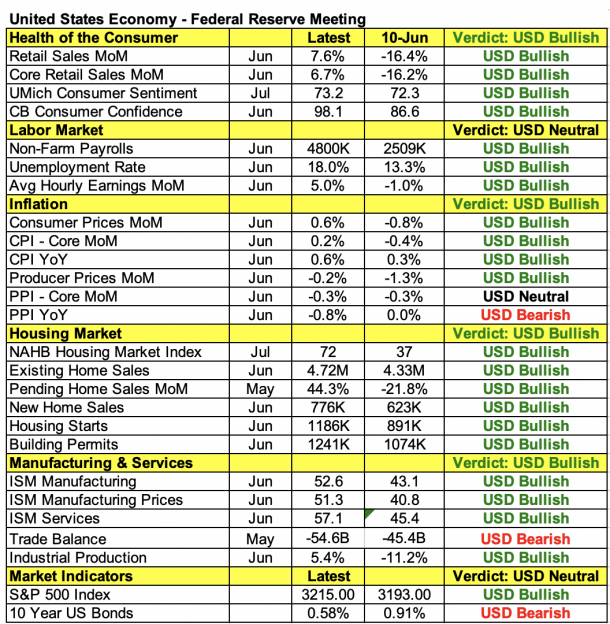Today, we saw the Federal Reserve “front-run” Wednesday’s FOMC announcement by extending its $2-trillion+ lending programs another three months to the end of the year. According to the central bank, it was necessary to “provide certainty that the facilities will continue to be available to help the economy recover.” But, in reality, it is worried about the economy and feels more companies will need to tap this lifeline. These actions send a strong signal to investors that come tomorrow, we’ll get a more cautious tone from the Fed. We are not looking for any monetary policy changes, but with extra unemployment benefits expiring and COVID-19 cases rising, the central bank will be forced to look past the improvements in the economy since June.
The table below shows broad-based improvements in the U.S. economy since the last Fed meeting. Had virus cases stabilized with no significant upticks over the past month, the Fed would be talking about the improving recovery and how the worst is over. Unfortunately, that’s not the case right now and instead, the two greatest threats to the U.S. economy are things the Federal Reserve has no control over – the rapid spread of coronavirus in the U.S. and the government’s fiscal response.
A few weeks ago, Chairman Jerome Powell warned law-makers not to become complacent as the U.S. economy remains extraordinarily uncertain. Since then, the outlook worsened, extra unemployment benefits expired and the packages that Congress are discussing could fail to impress. For all these reasons, we expect nothing but ongoing dovishness from the Fed along with a pledge to keep monetary policy accommodative for the foreseeable future. Last month, they said rates will remain at zero through 2022.
The U.S. dollar has fallen extensively ahead of the rate decision. Treasury yields also moved sharply lower, which tells us that investors are positioning for dovishness. How the greenback trades tomorrow will depend on Powell’s tone. Back in June, he said a second-half recovery is likely, but with virus cases rising rapidly, his outlook will certainly change. Considering that the market expects cautiousness, we may not see a big dollar move post FOMC – unless the central bank mentions that negative rates are back on the table, which could unleash a fresh round of U.S. dollar selling.
